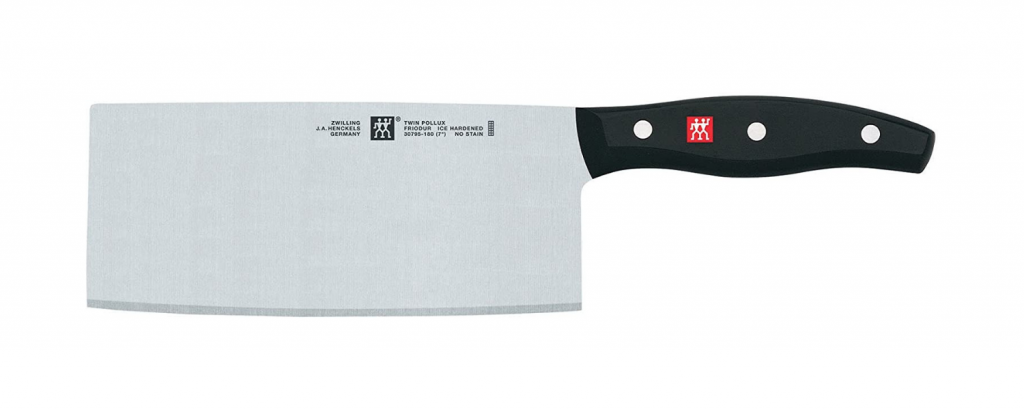You might have just bought a knife set, and you are starting to wonder how some of kitchen knives can make your life easier. Or you might be considering adding the best knife set to your kitchen. Either way, knowing the kitchen knives uses can open a whole new world as a cook. What works for one type of food may not excel when cooking others. To help you make sense of it all, this guide delves into types of knives and their uses.
Chef Knife

Source & Purchase from: Amazon
Others call it a chef’s or cook’s knife – it has a long and broad blade that becomes thinner to a point to enhance the back and forth rocking motion for faster mincing. Chef knives can range from 6 to 12 inches long with a straight edge. The suitable size is determined by the size of the cook’s hands.
A chef’s knife can be stamped, but the best knives are usually forged. Due to frequent usage of the chef’s knife, it’s typical of these knives to have a full tang (extends to the whole length and width) to ensure durability and bring better balance than a partial tang.
The chef’s knife is commonly called “the king in the kitchen” because it can be used for almost every cutting task, from chopping and dicing veggies. The broad heel also makes it suitable for heavy-duty cutting chores.
Santoku Knife

Source & Purchase from: Amazon
The santoku bocho knife is one of the most popular types of kitchen knives in Japan. It’s the Japanese version of the chef’s knife though slightly thinner and shorter. Some cooks use this knife in place of the chef’s knife, especially those who like a lighter blade. Japanese people use the Santoku knife for slicing, mincing and dicing. This all-rounder knife can do anything a chef’s knife can.
Sometimes the knife has a hollow edge with dimples along the edge, making it suitable for cutting through meat, fish and other tough materials without food debris sticking to it. Some of the santoku knife uses include cutting prime meats, dicing veggies, slicing herbs, and chopping nuts.
Utility Knife

Source & Purchase from: Amazon
This one has a similar shape to the chef’s knife but is relatively smaller and slimmer. A utility knife is typically about 6 inches long, so you can pull out the utility knife instead when the chef’s knife is too big for the job. Most utility knives also come with a sharp tip for more intricate work. The utility knife shares many qualities of a chef’s knife, but it’s ideal for cutting smaller veggies like shallots where precise cutting work is needed. This “knife of all trades” can help slice tender pieces of meat and fruit.
Paring Knife

Source & Purchase from: Amazon
A paring knife is short, pointed, and has an evenly sized blade. It can be used for the same tasks as the utility and chef knife on a smaller scale, especially for cutting jobs requiring more precision. Paring knives are suitable for peeling and detailed mincing and cutting. The blade is about 3.5 inches, ideal when you want to garnish.
Other paring knife uses include cutting tender veggies and fruits such as ginger, garlic, shallots, and strawberries. Avoid using this knife for hard vegetables, as you’ll likely apply an unsafe amount of force that could cause injuries.
Boning Knife

Source & Purchase from: Amazon
In case you want to remove meat from a bone, use this long and strong knife. The boning knife thinness makes it effortless to move with the curves of the bone and remove every piece of meat effectively. There are two types of boning knives, one with a flexible blade and another with a stiff blade. The flexible blade allows for skin removal from bones of fish and poultry, while the one with a stiff blade provides the greater force needed when cutting cuts of meat such as beef or pork.
Fillet Knife

Source & Purchase from: Amazon
A fillet knife looks so similar to a boning knife, but there are a few minor differences. For one, a boning knife is thicker and has a better endurance to remove meat from a bone. Meanwhile, the fillet knife is designed to cut fish into thin slices, so it’s typically longer, thinner and more flexible. Still, the difference is too subtle that sometimes the two knives can substitute each other. Many knifemakers blend the two hence the rise of the boning fillet knife. However, expert chefs of sashimi or chicken boning can probably distinguish the two.
Bread Knife

Source & Purchase from: Amazon, More Introduction
The bread knife is similar to a saw with a long, evenly sized blade and a sharp serrated edge. The design is perfect for sawing through all kinds of bread, including bagels, crusty bread, baguettes and bread rolls. The grooved edge makes it easier to slice through softer textures accurately. Bread knives can also slice other softer foods like fluffy cakes because they can cut through without damaging the shape. A bread knife can be anywhere between 7 to 10 inches long.
Carving Knife

Source & Purchase from: Amazon
A carving knife also called a slicing knife, is longer than many kitchen knives and tapering to a sharp point. The narrow width ensures less drag as it cuts through food, allowing for more uniform, cleaner slices. When you want to cook meats, a carving knife is suitable for the job as it slices neat and evenly sized pieces. The knife is also ideal for cutting larger veggies and fruits such as melons, which are harder to slice using broader or shorter knives. The thin blades are also suitable for cakes due to their length and smooth cutting motion.
Cleaver Knife

Source & Purchase from: Amazon
Also known as a butcher knife, this is one of the broadest and heaviest knives in the kitchen. Cleavers come in different sizes, depending on their use. The main use is to chop up raw meats during the butchery process and divide the portions before cooking. The heavy-duty design also makes them ideal for crushing bones. You can also use the knife to crush ginger and garlic against a chopping board.
Steak Knife

Source & Purchase from: Amazon
Also known as table knives, steak knives come in handy for cooked food. They work great for fish, chicken and steak. They usually feature serrated or mini-serrated edges, but they can stay sharp for a long time without requiring honing. Some steak knives are non-serrated, but these lose the sharpness much faster, although they are easier to sharpen.
Peeling Knife

Source & Purchase from: Amazon
A peeling knife is short and rigid with a slightly curved blade. The edge is straight and extremely sharp. As the name suggests, the knife is used for peeling potatoes, vegetables and fruits, and the sharp edge can slice tough skins. The ergonomic handle of a peeling knife helps to prevent slipping during peeling work.
Cheese Knife

Source & Purchase from: Amazon
Soft cheese sticks on knives, the reason for the holes you see in a cheese knife. The holes basically minimize the cheese’s contact with the knife for a mess-free experience.
Conclusion
So, there you have a quick round-up of the different types of cooking knives and their uses. While some knives are only designed for a single job, others are versatile.
Having a set of kitchen knives will allow you to prepare food easily, efficiently and safely. Now that you know the different uses of knife, you can shop for a new set with confidence. Don’t forget to have a honing rod as part of the collection because dull knives can slow you down and increase the risk of injury.
